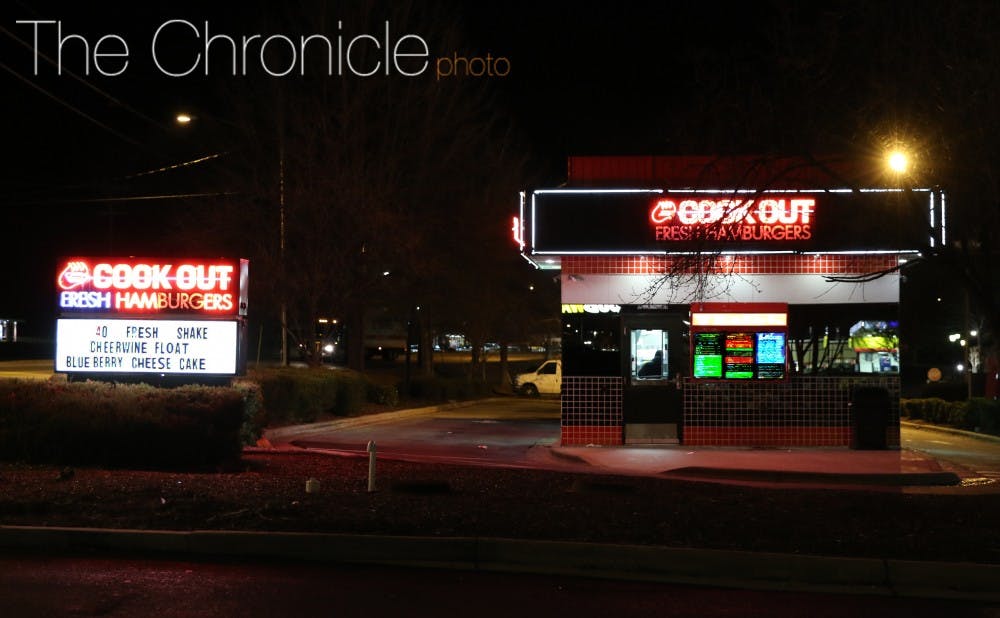My high school, situated in the heart of Cary, N.C., regarded itself as the last bastion of the American high school experience.
In the midst of a rapidly developing area, the overriding spirit at school was one of intense pride in our roots and veiled indignation toward our changing surroundings—so much so, in fact, that we decided to tack on a giant “THE” in front of our name, Ohio State-style, as if to remind the country clubs and Northern transplants who was here first. Even with a diversifying student body, our core values remained stubbornly grounded in traditional Southern ideals. We loved Friday night football (even if we rarely won), we loved our troops and, above all, we loved America.
The school found its spiritual kin in Cook Out, which boasted a location just a mile down the road from campus. It was not uncommon after lunch hour to see half a class wielding take-out trays and sipping from red-striped Styrofoam while staving off milkshake-induced food comas.
Like the high school whose business helps keep it running, Cook Out consciously embodies the tropes of Southern identity. Founded in Greensboro, N.C. in 1989, the fast food chain didn’t set foot outside its native state until 2010. The sprawling menu features regional favorites like vinegar-based barbecue, hush puppies and sweet tea. Wrappers and containers are even marked with verses of scripture.
I didn’t expect the Cook Out craze to carry over when I moved to Durham—Duke, after all, is hardly representative of the South. (And it appears the restaurant’s loyalties lie elsewhere.) But at a place like Duke, the restaurant’s brand makes Cook Out a novelty for out-of-state students eager to adopt the quirks of their new home. This experience usually comes at the cost of comparison with one’s own local chains, as anyone who’s had to listen to someone sing the praises of In-N-Out can attest.
Cook Out’s biggest fans at Duke, however, are the in-state students who grew up in high schools just like mine. First-year students Clayton Delp of Fuquay-Varina and Ethan Ready of Chapel Hill both described experiences with the restaurant that mirror those of most kids from North Carolina—impromptu late-night trips, post-football-game celebrations (or consolations), convenient stops on the way back home.
“People are just generally very defensive about their regional fast food chains. That’s something I’ve noticed at Duke,” Delp said. “Coming from North Carolina, I almost think of [Cook Out] like part of the state, and so there’s sort of this state pride wrapped up in my love for Cook Out.”
Underpinning Cook Out’s appeal is its commitment to value. In what could be a case study of the accomplishments of the capitalist age (or the ills, depending on whom you ask), a customer can order a three-course, thousand-calorie permutation of burgers, quesadillas, fries, sides and drinks for a terrifyingly low $4.99. Dubbed the Cook Out Tray, this is undoubtedly the most popular item on the menu.
Perhaps more than any sense of regional identity, this affordability makes Cook Out especially attractive to college students on a budget. The fact that the value applies to a diverse menu including upwards of forty different flavors of milkshake means that anyone can find something to love at Cook Out.
“Whatever you’re in the mood [for], you can find it at Cook Out,” Ready said. “Whatever you want, you can find it there, and it’s really cheap.”
As a result of this value, Cook Out makes food that straddles a fine line between delicious and disgusting. Like Waffle House, its closest aesthetic cousin, much of Cook Out’s appeal lies in its frugal, no-frills approach to fast food.
While lesser fast food chains might cloak their products in a veneer of health-consciousness or renovate their bathrooms in an attempt to pass as “nice,” Cook Out keeps things plain and simple. A nondescript menu greets customers in the drive-thru line. A large iced tea isn’t just a large iced tea; it’s a “HUGE ICED TEA,” just to clear any notions that this stuff might somehow be good for you. Instead of windows, the restaurant’s sides are lined with metal mirrors, a wise measure that forces customers to confront their own reflection before proceeding with their order. (When you gaze long enough into the abyss, the abyss gazes back.)
Because nearly every location is identical, the Cook Out experience only varies insofar as your choices off the menu do. When you pull into a Cook Out, whether at lunch or at 3 a.m., you know exactly what to expect. You know a Cook Out Tray will hit the spot, you know it will in all likelihood leave you writhing in pain for the next five hours and you know you will regret nothing.
That this form of high-calorie indulgence comes wrapped, both physically and figuratively, in an old-fashioned patriotism that’s inseparable from the state the restaurant calls home explains why locals and Duke students alike will continue to flock to Cook Out for years to come.
Recently, Cook Out’s commitment to its brand seems to have paid off. If Google Trends is to be believed, nationwide interest in the chain has nearly doubled in the last five years, and locations have opened doors throughout the Southeast.
But to anyone from this area, Cook Out will always be a uniquely North Carolinian brand. By clinging to sometimes outmoded traditions of its region, the fast food chain has perhaps unexpectedly staked itself out as a modern success story, an essential element of the Carolina experience.
Get The Chronicle straight to your inbox
Signup for our weekly newsletter. Cancel at any time.

